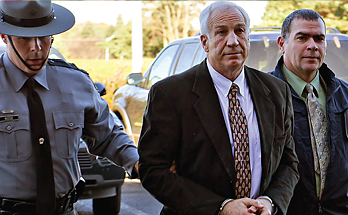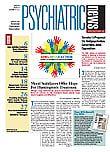Just when you thought that the worst things about college football were arrogant coaches, recruiting violations, sneaky sports agents, unscrupulous boosters, exploited “student athletes,” bloated television contracts, and shady deals for the quarterback’s parents, along comes Penn State.
By now, the charges revealed in a Pennsylvania grand jury presentment are well known even to people who can’t tell a linebacker from a ballerina.
In brief, retired Pennsylvania State University assistant football coach Jerry Sandusky is charged with 40 counts of sexually abusing young boys over a decade and a half, sometimes in the shower room of the university football team. He was allegedly observed in the act there at least twice, once in 2000 by a janitor and again 2002 by a graduate assistant. Information about the cases is coming out piecemeal, but so far campus police say they have no record that they were notified in either of those instances.
Meantime, Joe Paterno, Penn State’s revered, 84-year-old head coach for life was fired, the university president (Graham Spanier) dismissed, and two other administrators indicted for perjury for lying to the grand jury.
Rumors about Sandusky’s behavior had circulated for years within the athletic department and possibly beyond, but it appears that nothing was done or even revealed, according to several sources.
Today, still more heads are likely to roll, and a major university lies stunned, its reputation tarred by the accusations and by the alleged failure of those concerned to do more than pass the buck or suppress information. Former FBI Director Louis Freeh has been named to head an investigation of the whole matter.
Patterns of Abuse
In a televised phone interview shortly after the grand jury’s findings were made public by Pennsylvania Attorney General Linda Kelly, Sandusky said he was “just horsing around.”
“I’ve heard that before,” said Judith Cohen, M.D., a professor of psychiatry at Temple University and medical director of the Center for Traumatic Stress in Children and Adolescents at Allegheny General Hospital in Pittsburgh.
“When I heard the term ‘horsing around,’ I knew exactly what was going on,” said Cohen, an expert on child sexual abuse.
While the media generally reported on the allegations, the turmoil, and the effects that Paterno’s firing might have on the football program, little public attention was paid to the anonymous victims of the abuse.
That comes as no surprise to Cohen.
The Sandusky case makes people think they would handle such events differently if they saw someone abusing a child, she said. But child sexual abuse is severely underreported, and it is rare that abusers are caught in the act.
Cohen believes that rates of child sexual abuse in Pennsylvania are probably similar to those in other states, but reported rates are lower because criteria in the state are more difficult to meet than elsewhere.
“Pennsylvania has a high threshold for reporting child abuse,” confirmed Scott Hollander, J.D., executive director of KidsVoice, an advocacy organization in Pittsburgh supporting abused, neglected, and at-risk children.
Current law says that the abuse must be intentional, at the hands of a caregiver, have caused serious physical injury, or be sexual abuse. Each of those terms is open to interpretation, said Hollander in an interview.
For instance, in one place, the law says that teachers, coaches, and principals are caregivers, while another section suggests that any employee of a school is covered.
Hollander cited a case in which a child who was being beaten with a belt turned and was struck in the eye by the belt buckle. The resulting severe eye damage was not deemed child abuse because it was “not intentional,” he said.
The rush in Pennsylvania to pass new legislation to change reporting standards ignores serious flaws in the system, said Hollander.
“Currently, 9 percent of the calls to child abuse hotlines are unanswered or go to voicemail, or people hang up when they’re put on hold,” he said. “We need to add capacity and provide more services for treatment before we have still more people call in and not get help.”
KidsVoice is backing the efforts of one state lawmaker who wants to create a task force to examine all the issues first and then provide recommendations to the legislature by next spring.
Reporting Abuse
“Almost always it’s the child who reports the event and that’s when people have to rise to the occasion and believe the child or at least raise questions,” Cohen said. “Unfortunately, in so many cases, the community ostracizes the child and rallies around the [alleged perpetrator].”
If authorities who are supposed to protect children don’t do a good job, the children learn a number of negative lessons, she said. They think that no one cares or no one believes them or even that it’s all right for adults to do what they did.
“They begin to think bad things about themselves,” she said. “These are already vulnerable kids and have doubts about themselves—something that an abuser often picks up on.”
A twin study published by Australian researchers in 2002 showed that adults abused sexually as children had increased rates of depression, suicide attempts, PTSD, conduct problems, alcohol abuse, and nicotine use. Even higher rates occurred among those who had endured intercourse.
Reporting abuse after a delay of years may introduce yet another difficulty for victims, said Steven Cuffe, M.D., chair of the Department of Psychiatry at the University of Florida College of Medicine in Jacksonville.
“Frequently, they have trouble being taken seriously and are called ‘unreliable’ witnesses if their response to abuse has resulted in psychological problems in the interim,” said Cuffe, who is also chair of APA’s Council on Children, Adolescents, and Their Families.
Effects vary from individual to individual, however.
“Don’t underestimate the resilience of children,” said Cuffe in an interview. “With the appropriate response, children can function well after abuse like this, depending on the severity and chronicity of the events.”
The first goal is to make sure the child is safe, so there is no recurrence of abuse, said Cuffe. Then, a therapist can work with the family to provide as much support as possible. That is more difficult if the abuser came from within the family.
Evidence-based, trauma-focused therapies can be effective, he said. One of the best tested is “trauma-focused cognitive-behavior therapy,” which Cohen helped develop.
“There are advantages to early intervention,” said Cohen. Biological changes occurring over time in the brain can take their toll. Medical costs connected with these disorders can be heavy.
“Even if those changes are reversed, you can’t turn back the clock on all the pain and suffering that have taken place over the years,” said Cohen.
Origins of Abuse
A variety of factors can explain why someone desires sex with a child, said Frederick Berlin, M.D., Ph.D., an associate professor of psychiatry at Johns Hopkins University School of Medicine, who treats patients diagnosed with pedophilia.
Not all have a sexual disorder, he said. Some are impaired by drugs or alcohol, some lack a conscience or moral responsibility. Some may display increased libido during a manic episode and act in sexually inappropriate ways.
However, a subgroup—those with pedophilia—is predisposed to seek out sexual activities with children because there is something abnormal about their sexual makeup.
“There’s a lot we don’t know about these issues,” said Berlin. “We do know that who we are attracted to is not a matter of voluntary choice.”
Imaging research has shown some brain differences among those with pedophilia compared with those who do not have that diagnosis. There is also some evidence that some (but not all) children who were sexually abused have a greater predisposition to developing pedophilia.
“In the past, pedophilia was seen as a moral issue, but there is a tremendous need—not just for people with pedophilia, but for the larger society—to learn more about factors that contribute to its development, how to prevent it, and, for people who have it, to provide treatment so they can live safely in the community,” said Berlin
Pedophilia is a craving disorder, like alcoholism or drug abuse, he said. Treatments that work well with those disorders also are used for pedophilia (see
Strategies for Preventing Sex Abuse). Group therapy often helps patients confront self-deceptive thought processes and look more rationally at their actions, said Berlin.
Lifestyle changes, like avoiding being around children, can help.
“Maybe someday we’ll know enough about the biological differences in sexual disorders to change the qualitative nature of a person’s desires,” he noted. “But in 2011, we’re nowhere near that point.”
Ironically, laws intended to help sexually abused children may work against bringing persons with pedophilia into treatment, said Berlin. For instance, psychiatrists in Maryland have to report any suspected incident of child sexual abuse, which probably keeps many potential patients from even inquiring about treatment.
Finally, it is not uncommon in controversies in college athletic programs that people assume that the problem will be resolved magically by someone else without dangerous consequences for them or for the school, said sports historian Dave Zang, Ph.D., a professor of kinesiology at Towson University near Baltimore.
In college football, the coach becomes the authority figure, not the police or child- welfare people, said Zang in an interview. And that may have been the paradigm followed when the grad assistant told Paterno what he saw in the shower and Paterno told his athletic director.
Sports sociologists sometimes compare sports to cults, and that isn’t far off base, he said.
“The view inside teams or athletic departments is: those outsiders can’t understand us,” said Zang. “So when things go wrong, they figure they’ll fix it themselves.”
Strategies for Preventing Sex Abuse
Child sexual abuse is certainly not limited to college campuses, but the presence of minors on university grounds is not unusual, said Nancy Tribbensee, J.D., Ph.D., senior vice president for academic, legal, and external affairs at the Arizona Board of Regents in Phoenix and board secretary for the National Association of College and University Attorneys.
Universities often hold youth sports or drama camps. Young people attend campus performances or athletic events, and a constant stream of high school students visits campuses as prospective students. Also, many freshmen may not yet have reached their 18th birthdays when they first arrive at college.
Institutions can do a lot to prevent incidents on campus from occurring in the first place, Tribbensee, whose doctorate is in counseling psychology, told Psychiatric News.
University legal counsels can vet programs for underage youth to maximize safety and minimize risk to both the children and the institution, she said. (Penn State’s legal counsel said he was never told about alleged child abuse by former coach Jerry Sandusky, according to media reports.)
Counsel can help develop policies and procedures to both prevent problems and deal with cases when prevention fails.
A university also should have systems in place to report and investigate allegations, said Tribbensee. That includes reporting mechanisms that don’t jeopardize an informant’s job.
Information about crimes on or near campuses must be reported. All postsecondary education institutions must disclose to students, employees, and the public information about security policies and campus crime (including sex offenses) under federal law, said Tribbensee.
Campus or local police cannot investigate if they never hear about possible crimes, said Paul Verrechia, M.P.A., chief of police and director of public safety at the College of Charleston in South Carolina, in an interview.
“This is a difficult case,” said Verrechia, who is also president of the International Association of Campus Law Enforcement Administrators. “The only thing I’m doing is what I did before the Penn State case: I’m encouraging people to report incidents to us. If you see a violation of the law, call the police.”


